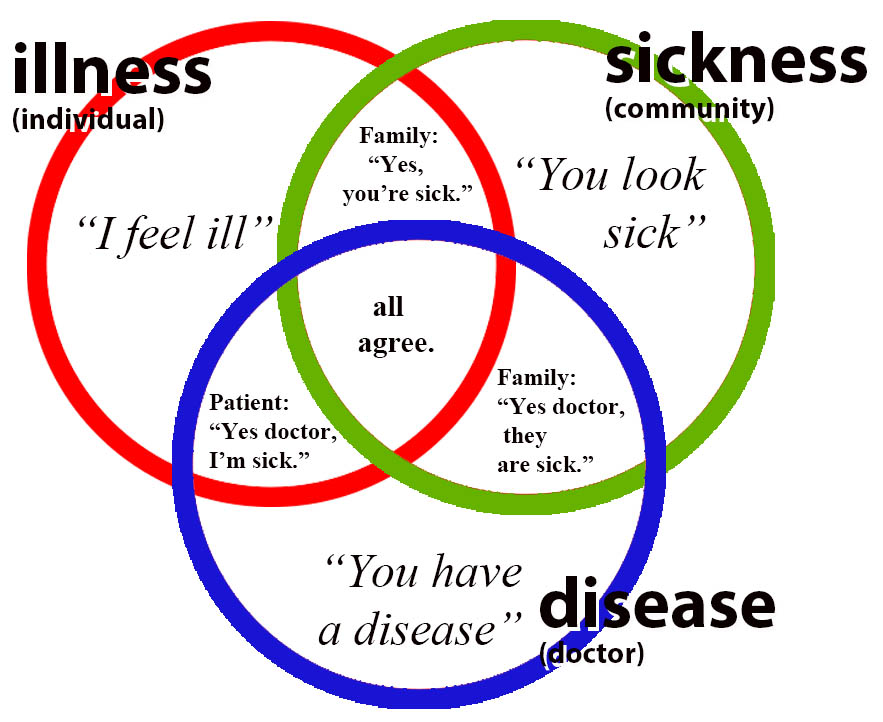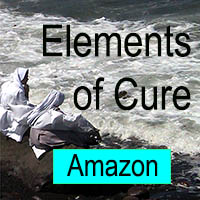The University of Ottawa suggests three views: illness, disease, sickness. What’s the difference? Which is cured?
The illness is what the patient perceives, sickness is what their communities perceive, and disease is what the medical community diagnoses (perceives). There are, of course, many issues. Patient’s can be misled by their senses, by their communities, and by their doctors. Each patient lives in many communities, which can have different views and different opinions. A single patient might visit several doctors, possibly different types of doctors, and receive different diagnoses.
We can, from a cure perspective, remove SICKNESS from the discussion. The patient’s communities have no techniques to judge sickness nor cured. Let’s focus on the differences between illness – the patient’s perspective and disease – the medical perspective.
What is the difference between an illness and a disease? There are many important distinctions.
Not all illnesses are diseases. Not all diseases are illnesses. Where is the truth? We have many perspectives, but where is the reality? How can we know?
The closer we look, the more differences we find. How can we find cures? Do we cure a disease, or do we cure an illness? What if the disease is cured but the patient is still ill? What if the patient claims to be cured, but the doctor says it’s only remission?
Medical Speak: Diseases are Incurable
In the medical system, there are few if any cures. Cured is not defined for most diseases. There are no statistics for diseases cured. Many, perhaps most doctors refuse to use the word cure and advise their staff to do the same.
Does cure require agreement? Can we cure an illness without diagnosis? Can we cure diseases even if the doctor’s can’t diagnose cured? Can illness be cured? Can sickness be cured?
Curable
To cure, we must cure something that is curable, and can be proven to be cured. But there is no word for a curable disease. The concept of a curable disease hardly exists. A few infectious diseases can be cured – but – “there is no cure for the common cold, influenza” and many more..
Curable Illness
In healthicine, the term curable illness defines a medical condition, a negative health condition, that can be cured. A curable illness can be cured.
When an illness cannot be cured, it’s not a curable illness. What is it? We’re back to the circles. It might be an illness, the patient’s view. It might be a disease, the physician’s view. It might be a sickness, the community view. It might be one of the above, or any two, or all three. It might be a disability, a disorder, a medical condition, a handicap. We’re not sure until we ask the patient, the doctor, or the community – and they might give different answers.
When it’s a curable illness, it can be cured, by definition.
The term curable illness is the first step to finding cures, the first stage of a theory of cure. Only a curable illness can be cured. The patient might be ill with a curable illness. The doctor might see a disease that is a curable illness. The community might see a sickness that is a curable illness.
The curable illness is a reality, not a point of view.
The next question is obvious. How do we cure a curable illness. And the next after that, not so obvious, how can we know, how can we prove it is cured?
An illness element is cured when:
- the cause has been successfully addressed
- healing has completed
- the signs and symptoms have faded and gone
- no more medicines are necessary.
A cure proves the cause. There is no better proof of cause.
 to your health, tracy
to your health, tracy
Author: The Elements of Cure
Author: A Theory of Cure
Founder: Healthicine: The Arts and Sciences of Health and Healthiness



